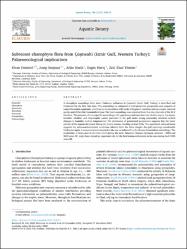| dc.contributor.author | Demirci, Elvan | |
| dc.contributor.author | Sanjuan, Josep | |
| dc.contributor.author | Nazik, Atike | |
| dc.contributor.author | Meriç, Engin | |
| dc.contributor.author | Yümün, Zeki Ünal | |
| dc.date.accessioned | 2023-05-06T17:19:38Z | |
| dc.date.available | 2023-05-06T17:19:38Z | |
| dc.date.issued | 2023 | |
| dc.identifier.issn | 0304-3770 | |
| dc.identifier.issn | 1879-1522 | |
| dc.identifier.uri | https://doi.org/10.1016/j.aquabot.2022.103613 | |
| dc.identifier.uri | https://hdl.handle.net/20.500.11776/11898 | |
| dc.description.abstract | A charophyte assemblage from lower Holocene sediments in ces,mealti (Izmir Gulf, Turkey) is described and illustrated for the first time here. This assemblage is composed of well-preserved gyrogonites and oospores of Lamprothamnium papulosum, which occur in association with seeds of Ruppia cf. maritima and up to eight ostracod species and 22 benthic foraminiferal taxa. The fossil assemblage was extracted from five clay intervals of the SK-2 borehole. The presence of monospecific assemblages of L. papulosum indicates that very shallow (up to 1 m deep), brackish, alkaline, and oligotrophic waters prevailed in the gulf under strong seasonality (marked cyclical changes in humidity and/or temperature). The dominance of germinated gyrogonites suggests that the water salinity of the lagoon decreased during the humid season, reaching at least 10 parts per thousand. The associated ostracod fauna supports the palaeoenvironmental conditions inferred from the flora. Despite the gulf receiving considerable freshwater input, it remained semiconnected to the sea, as indicated by the diverse foraminifera assemblage. The availability of freshwater in the Izmir Gulf during the early Holocene Climatic Optimum, between-9000 and 5000 years BP, might have played an important role for the first human settlements in the area dating back 5500 years BP. | en_US |
| dc.description.sponsorship | Project TUBITAK, 2214-A International Research Fellowship Program (The Scientific and Technological Research Council of Turkey) [1059B142100601]; Spanish Research Agency (AEI) [PID2020 - 113912 GB -100]; European Regional Development Fund (ERDF) [PID2020 - 113912 GB -100] | en_US |
| dc.description.sponsorship | This study was funded by the project TUBITAK, 2214-A International Research Fellowship Program 1059B142100601 Fellowship Number (The Scientific and Technological Research Council of Turkey) . This work is a contribution of the project IBERINSULA (PID2020 - 113912 GB -100/AEI/10.13039/501100011033) of the Spanish Research Agency (AEI) and the European Regional Development Fund (ERDF) . The authors thank the Yumun Engineering Limited Company who performed the borehole campaigns and provided the studied samples. The editor Dr. Elisabeth Gross and two anonymous reviewers greatly improved the manuscript. The English text was cor- rected by Michael Maudsley (Serveis linguistics , University of Barcelona) . | en_US |
| dc.language.iso | eng | en_US |
| dc.publisher | Elsevier | en_US |
| dc.identifier.doi | 10.1016/j.aquabot.2022.103613 | |
| dc.rights | info:eu-repo/semantics/openAccess | en_US |
| dc.subject | Charophyta | en_US |
| dc.subject | Quaternary | en_US |
| dc.subject | Microflora | en_US |
| dc.subject | Ostracoda | en_US |
| dc.subject | Foraminifera | en_US |
| dc.subject | Palaeoecology | en_US |
| dc.subject | Ruppia-Maritima | en_US |
| dc.subject | Lamprothamnium | en_US |
| dc.subject | Quaternary | en_US |
| dc.subject | Australia | en_US |
| dc.subject | Indicators | en_US |
| dc.subject | Morphology | en_US |
| dc.subject | Sea | en_US |
| dc.title | Subrecent charophyte flora from Çesşmealti (Izmir Gulf, Western Turkey): Palaeoecological implications | en_US |
| dc.type | article | en_US |
| dc.relation.ispartof | Aquatic Botany | en_US |
| dc.department | Fakülteler, Çorlu Mühendislik Fakültesi, Çevre Mühendisliği Bölümü | en_US |
| dc.identifier.volume | 186 | en_US |
| dc.institutionauthor | Yümün, Zeki Ünal | |
| dc.relation.publicationcategory | Makale - Uluslararası Hakemli Dergi - Kurum Öğretim Elemanı | en_US |
| dc.authorwosid | demirci, elvan/HJI-3417-2023 | |
| dc.identifier.wos | WOS:000923071900001 | en_US |
| dc.identifier.scopus | 2-s2.0-85145304873 | en_US |



















